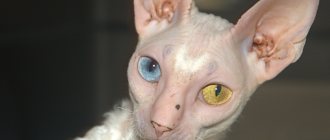What will you learn from the article?
- Origin story
- Description of the German Rex breed
- Color
- Character
- Care and health
- How much does a German Rex cat cost?
- Nurseries
The German Rex is a breed of domestic cat whose main feature is its slightly curly coat. In this way they are similar to the Cornish Rex breed, although their whiskers do not curl as much. But in terms of body structure, the German Rex is more reminiscent of a European shorthair cat. Most cat organizations: FIFe and WCF, recognized this breed as an independent breed. Only the CFA considers it a variety of Devon Rex and does not consider the differences between the breeds to be significant.
Origin of the Cornish Rex breed
The Cornish Rex first appeared in the heart of Great Britain in the 1950s. The very first Cornish Rex was named Callibunker, he was the son of Serena. This curly-haired cat was named Cornish Rex to evoke the rabbit that appeared on a farm in France in 1919.
The Cornish Rex was officially recognized in 1967. In 1957, a breeding program for this breed was created in the United States.
Currently, this cat breed is especially popular not only in the United States, but also in Europe, in particular in Russia.
Health
Cornishes are very strong and healthy animals, rarely get sick, and have no hereditary pathologies. Their Achilles heel is colds and cystitis, so the breeder should pay attention to open windows.
Surgeries are difficult to endure because they are too sensitive to anesthesia. A distinctive feature of the skin is a predisposition to rashes from the wrong foods.
In rare cases, specific endocrine diseases are observed, signaling the marriage of the entire genetic line:
- Diseases of the pancreas.
- Hypotrichosis (hair loss).
- Problems with the thyroid gland.
Character and behavior of the Cornish Rex
The Cornish Rex is often called the ideal pet for everyone. Indeed, he is especially capable of adapting to all the people around him. Smart, gentle, affectionate, loves hugs and very often asks for attention from the owner.
Very happy playing, because this cat loves to play. Particularly for this reason, it is ideal for living with children, with whom a lot of patience will be required. It should be borne in mind that the Cornish Rex retains its kitten character during the first fifteen years of its life.
So you constantly have the feeling that this kitten is not growing up. The Cornish Rex is sometimes compared to a dog because it does not shy away from being chased by its owner and does not tolerate being alone. He still values his independence but enjoys the company of his family.
What should you pay attention to when buying a Cornish Rex?
When choosing a Cornish Rex of any age, first of all you should pay attention to the kitten’s parents, because this is what the chosen animal will look like as an adult.
It is recommended to familiarize yourself in advance with defects and disqualifying defects (can be found in the breed standard), which, as a rule, are inherited. If the parents have visible defects in appearance or behavior, then you should think about whether it is worth the risk, and when buying a Cornish Rex for exhibition or breeding, you should completely refuse to buy a kitten from such producers.
When choosing a show- and breed-class kitten, it is strongly recommended to seek the help of specialists , and never buy such kittens by hand or without looking (on the Internet).
After making sure that everything is in order with the parents’ appearance and behavior, you should familiarize yourself with their documents. If the buyer has no idea what kind of documentation cats should have and what it should look like, then this can be clarified on the official website of any cat club.
Article on the topic Cornish Rex
Next, you need to make sure the adequacy and health of the selected kitten. Real Cornish Rexes are very smart and affectionate, with a “knowing” look. These features are noticeable even in very young kittens. You should check with the breeder for information about childbirth, their vaccinations, injuries and other similar health issues.
To have an idea of what diseases your kitten may develop in the future, you should ask about the health of the breeders. Here we should dwell on the issue of sterilization or castration. These operations do not harm health and do not lead to developmental delays, as many believe. Most often, sterilization and castration is carried out in nurseries and only for kittens not allowed for breeding (pet class). This is done in order to maintain the “purity” of the breed line. This is a big plus for future Cornish Rex owners who want to buy a kitten “for the soul”, because they will be spared the “charms” of puberty and will save time and money that would have been spent on independently carrying out such procedures in veterinary clinics. You should also ask for advice on care, maintenance and feeding.
It is recommended to pay attention to the room in which cats are kept: how clean, spacious, comfortable it is for cats, and how many individuals are there. The breeder should be interested in who his buyers are, in what hands his pets will fall, otherwise, he should remember that the fate of the kittens does not interest him, and therefore his attitude towards cats is appropriate.
Cornish Rex kittens, 7 months
Health of the Cornish Rex breed
The Cornish Rex is a cat known for its good health. It supports winter and fall very well, but is still a little afraid of the cold. As an indoor cat for the most part, he likes to stay warm. It should also be taken into account that this cat breed is not a victim of any hereditary pathology. Regardless, your cat still needs to be vaccinated against the classic diseases that affect felines, such as rhinitis or rabies.
How to care for and what to feed?
The first thing you should pay attention to is your pet’s fur. Since it consists of only one undercoat, it does not need to be brushed often, once a week is enough. For this, a brush with natural bristles is recommended.
You simply cannot wash it more than once a month. Experienced owners recommend dry shampoo. A hairdryer is also prohibited - it can damage delicate skin.
When bathing, pay attention to the ears - moisture should not get inside. The animal behaves calmly in water. Rex skin is very sensitive to sudden changes in temperature and, especially, to drafts. It is important not to forget about the claws, carefully trimming them as they grow. A scratching post is a must.
Cornish cats are very active and require constant supervision. The fact is that these cats have fragile bones; a fall from the high shelves on which they like to climb so much can result in a fracture.
Corniches require a special diet, as they are prone to obesity. It is advisable to make a schedule. The food should be balanced, preferably premium ready-made mixtures. Food from the table is not suitable for their digestion; fish is especially prohibited.
In addition, veterinarians warn owners against mixing food with natural food, as this overloads the pancreas.
Rex cats are allergic and often have food problems with fluoride-containing foods and citrus fruits. These cats are prone to developing tartar, so you need to teach them to brush their teeth. The procedure should be carried out at least twice a week with cat paste and a brush.
Cornish Rex breed hygiene
Caring for a Cornish Rex is fairly simple, but care must still be taken to maintain the waves. To do this, we recommend using a baby brush or a fine comb so that you can gently comb through the cat's short hairs. Keep in mind that your pet will need to be brushed weekly. We also recommend that you clean her ears weekly, using cotton wool and lotion once.
You can also contact specialized salons to have your cat washed and combed, and, if necessary, trimmed. We recommend the Dog & Cat salon.
What documents should a purebred Cornish Rex have?
For purebred Cornish Rex, there is a standard set of documents , which includes a birth certificate (for kittens) or a pedigree (for adult cats) and a veterinary passport, which is issued at a veterinary clinic upon the first vaccination. When buying a kitten, it is advisable to conclude a sales contract and take a receipt from the seller about receiving money for the kitten.
The price of a Cornish Rex kitten depends on its class, color and blood line. Many breeders allow you to pick up a kitten between 12 and 16 weeks of age. At the age of 4 months, kittens are already sufficiently physically developed and socialized to adapt to their new environment. This is also the minimum age required to participate in the show and required for air travel.
If a breeder offers you an adult animal, agree without hesitation. This would be a great solution for a home where good manners are required. Keep your cat at home, sterilize it, and you will have a healthy, happy friend next to you for many years.
How to distinguish between a Devon Rex and a Cornish Rex kitten?
| Devon Rex | Cornish Rex |
| Small amount of guard hair | Wool without outer coat and coarse guard hair |
| The head is a modified wedge, the width of the head is almost equal to its length | The head is small, egg-shaped. One third longer than wide |
| Very wide and low set ears | Ears set high and straight |
| The body is gracefully built. The body is muscular, with fairly thin bones. The back is curved, forms an arch | All body contours are smoothly curved, long, non-tube-shaped body |
Authors: wolfonokW7, Guryeva S.
Origin story
The first representative of the German Rex breed is considered to be the cat Munch, who lived in the family of the German woman Erna Schneider in the 1930s near Königsberg. Therefore, the homeland of the “curly breed” is the territory of historical East Prussia. Hence another name - Prussian Rex. Munch got his original appearance as a result of mixing Russian Blue and Angora cats.
However, researchers call another cat the official ancestor of the breed - Lamchen (translated from German as lamb). In the summer of 1951, near a Berlin hospital, doctor Rosa Scheuer-Karpin noticed her. She found that a cat's curly fur is a gene mutation. It was the descendants of Lamchen who laid the foundation for the new breed. Although perhaps this cat herself was Munch’s “great-granddaughter”.
Another famous representative of this breed is the black and white curly cat Pushkin, who was born in 1969 near Cologne.
How to prepare your home for the arrival of a Cornish Rex kitten?
Before you bring your kitten home, prepare a separate room for it. Place there a litter box (tray), water and food, a safe place (where the kitten could hide) with a warm bed, and a few toys.
Prepare a carrier with absorbent diapers inside (if it’s cool outside, it’s better to insulate the carrier), this is where the kitten will go to its new home. When you arrive home, immediately go to the prepared room and release the kitten there. You can leave the room or sit on the floor and stay with him. Let the kitten come to you and pet him gently. Don't worry if he doesn't come to you right away, it's already hard for him. Make sure he is using the tray correctly. Over the next two days, communicate with the kitten more often and play with it.
When you play or pet him, reward his good behavior. Follow the diet recommended by the breeder for at least the first two weeks to ensure your kitten does not have any gastrointestinal problems. If you want to change your diet, it should take at least 7-10 days. Every day, add a little new food to the old food, each time reducing the volume of the old food and increasing the volume of the new one. You should switch to adult food no earlier than 8 months.
On the fourth or fifth day, you can allow the kitten to explore its new home. Before this, place several trays in the apartment, since at first he may get lost in the apartment and do his business in the wrong place. Let your kitten explore a new room or area of the house every day.
If you already have other pets, then getting to know them should be done gradually. It is not recommended to bring animals face to face. The main thing in this matter is to be patient. First, to start, show the animals to each other from afar, getting closer and closer every day. Place things that smell like animals in the kitten's room and, conversely, place things that smell like kittens where animals live.
When the animals get used to each other's smells, you can try to introduce them on neutral territory under your control. If you have a dog, it is advisable to put a muzzle on it (just in case).











